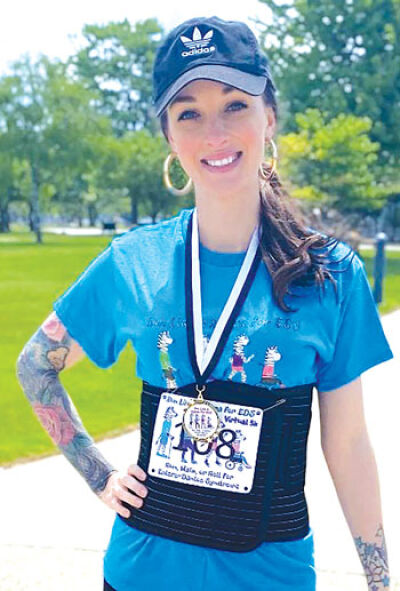
Amanda McLeroy, who has Ehlers-Danlos syndrome, said it took 10 years to find a diagnosis.
Photo provided by Amanda McLeroy
ST. CLAIR SHORES — Ehlers-Danlos syndrome causes severe pain and takes a long time to diagnose.
Amanda McLeroy, 32, of St. Clair Shores, who has EDS, searched for 10 years before she finally got her diagnosis around three years ago.
Ehlers-Danlos syndrome is a connective tissue disorder and there are 13 different types. McLeroy described connective tissue as the glue that holds the body together.
“Mine’s not good,” McLeroy said. “It’s falling apart.”
According to the Ehlers-Danlos Society, EDS is caused by genetic changes in the connective tissue. According to the group’s website, the main mission of the society is to advance and accelerate research and education in EDS and hypermobility spectrum disorders.
Those who have EDS all suffer with it differently, McLeroy said, at different levels of severity.
“The symptoms and issues present different in each of us,” McLeroy said. “Especially because there is 13 types. So you know some are more severe than the other type.”
Nina Fernandez, community support coordinator of the Ehlers-Danlos Society, said the prevalence of EDS is hard to answer. There are multiple studies reporting different statistics. She said at the Ehlers-Danlos Society, they support separating the statistics into the different types of EDS.
“We know some types of Ehlers-Danlos syndrome are rare or ultra rare whereas some are more common,” Fernandez said.
Fernandez said the hypermobility spectrum disorders and hypermobile EDS are estimated to be one in 600 to one in 900 and other types are more rare.
Before McLeroy lived in Michigan, she lived in California and started searching for answers there. McLeroy said she started developing chronic pain after her first child.
“I started seeing doctors out there,” McLeroy said. “Nobody knew what was wrong or like why nothing was working that would usually work for normal or would help subside the problem.”
She added she had to keep going to specialists in California and no one had any answers. When she moved to Michigan, someone mentioned going to the University of Michigan hospital system.
“I remember, one day, we drove all the way out there to go to the ER, and I waited in the ER for literally 13 hours,” McLeroy said.
Before this, McLeroy visited the ER before due to severe pain from migraines and other issues. She later said that she deals with chronic pain, popping and clicking throughout her body.
“I deal with different types of pain,” McLeroy said. “Lots of nerve pain, muscle pain, then the joint pain, then the rare forms of headaches, migraines I get.”
After waiting, she finally saw a specialist who was able to identify what she’d been going through.
“When I’d seen the specialist, he instantly knew, I guess by my features as well, about the Ehlers-Danlos syndrome,” McLeroy said.
McLeroy never heard of EDS before the diagnosis and started her research after that.
“It took that one special doctor after 10 years of trying to get answers from people,” McLeroy said. “To know what he was doing and then it was confirmed through rheumatologists and genetics. Yeah, I’m really thankful I waited the 13 hours.”
McLeroy said when she looks back to her childhood, she did have signs and symptoms of EDS. She said she saw it in her features such as her hypermobility, bladder problems and abnormally stretchy skin.
“My parents didn’t. They don’t have any of these health issues and they wouldn’t have known what to look for when I was a kid, but I did have signs,” McLeroy said.
She also said that EDS can skip generations and she could also be the one that started with EDS. Her eight half brothers and sisters as well as her parents don’t have EDS.
She sees 14 specialists because the symptoms of EDS cause other health issues throughout the body.
“For me personally, it’s affected also my GI tract, my muscles, joints,” McLeroy said. “Even my eyeballs. But I look so normal on the outside. So no one knows unless I were to say something because all my problems are on the inside.”
Ever since the diagnosis, she’s been in physical therapy and receives injections.
“Because there’s currently no cure, so it’s more of just managing, I guess, your symptoms,” McLeroy said.
McLeroy said early diagnosis is crucial to EDS.
“It’s just better to know things early on,” McLeroy said. “Because I didn’t know before having children and now, they show signs. So it would have been nice to know all that stuff and do preventive things to not be as severe.”
McLeroy said she wants to bring more awareness to EDS. She said she knows people who haven’t been diagnosed until they were in their 50s or 60s.
“It just needs to be more recognized and taken serious especially in the medical field,” McLeroy said.
She went on to say even though there’s no cure she still has to live with the symptoms.
“It’s just been a little bit of a struggle, I guess, going to all the different doctors and injections,” McLeroy said. “But it’s pretty much all you can do for now.”
Fernandez wants people to know that not everyone with EDS presents their symptoms the same. She said if doctors and people could understand the different presentations that those with EDS could get the help they need.
“You know, not everyone has the same phenotype. It could help lead to earlier diagnosis and better care,” Fernandez said.
Fernandez said people should be more aware of EDS and the people who have it.
“I think the more people that know about it the better care people will be able to receive,” Fernandez said.
 Publication select ▼
Publication select ▼























